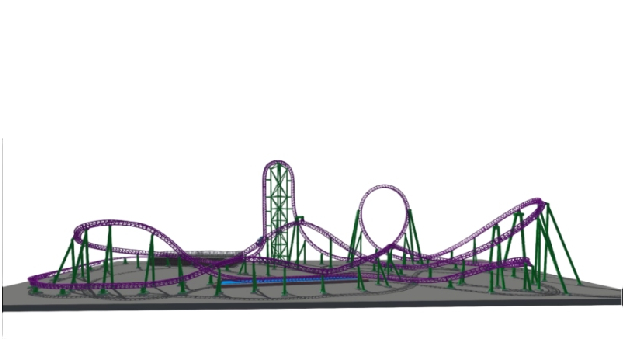- Albanian
- Arabic
- Belarusian
- Bengali
- Czech
- English
- French
- German
- Hebrew
- Hungarian
- Indonesian
- irish
- Italian
- Japanese
- kazakh
- Persian
- Russian
- Thai
- Uzbek
- Vietnamese
Exploring Various Types of Roller Coaster Experiences and Their Unique Thrills
Types of Roller Coaster Rides
Roller coasters are one of the most thrilling rides found in amusement parks and theme parks around the world. With their high speeds, steep drops, and exhilarating turns, they attract millions of visitors each year. But did you know that there are several distinct types of roller coasters, each offering a unique experience? This article will explore the various types of roller coaster rides available today.
1. Wooden Roller Coasters
Wooden roller coasters have been captivating thrill-seekers for over a century. Characterized by their traditional wooden structures, these coasters provide a nostalgic experience. Wooden coasters often feature a unique sensation known as “airtime,” where riders feel weightless at the crest of a hill. Notable examples include the legendary Coney Island Cyclone and The Beast at Kings Island, which boasts one of the longest wooden roller coaster tracks in the world.
2. Steel Roller Coasters
Steel roller coasters revolutionized the amusement park experience starting in the 1970s. They allow for more complex designs, loops, and inversions. Thanks to their smooth ride and ability to reach higher speeds, steel coasters have become the dominant form of thrill ride in many parks. Popular examples include Millennium Force at Cedar Point, known for its height and speed, and The Incredible Hulk at Universal’s Islands of Adventure, which offers a unique launch feature.
Inverted roller coasters twist the traditional design by suspending riders below the track. This design allows for several loops and inversions while offering a sense of weightlessness. Riders experience thrilling drops and sharp turns while being open to the air, creating an exhilarating sensation. Famous examples include Banshee at Kings Island and Montu at Busch Gardens Tampa Bay.
types of roller coaster rides

4. Floorless Roller Coasters
Floorless roller coasters take the experience of an inverted coaster up a notch by removing the floor beneath the riders’ feet. This design enhances the feeling of freedom and thrill. With riders' legs dangling in mid-air, every twist and drop feels even more intense. Notable examples are Kraken at SeaWorld Orlando and Ninja at Six Flags Magic Mountain.
5. Dive Coasters
Dive coasters are known for their thrilling drops that often exceed a vertical plunge. These rides typically feature an initial vertical lift, followed by a suspenseful pause at the top, allowing riders to take in the view before plunging down. The anticipation adds to the thrill, making them stand out among other coaster types. “Griffon” at Busch Gardens Williamsburg is one of the most famous dive coasters, showcasing a 90-degree drop.
6. Launch Coasters
Unlike traditional roller coasters, which use a lift hill to gain height, launch coasters propel riders forward at high speed from the start. This immediate thrill sets them apart, as riders are launched into a series of loops and inversions right out of the gate. Examples include “Top Thrill Dragster” at Cedar Point, which shoots riders to incredible heights in mere seconds, and “Xcelerator” at Knott’s Berry Farm, which features a rapid acceleration.
Conclusion
In conclusion, roller coasters come in a variety of types, each offering a unique mix of thrill, excitement, and adrenaline. Whether you prefer the classic feel of a wooden coaster or the intensity of a launch coaster, there’s a roller coaster out there to satisfy every thrill-seeker’s craving. As technology continues to evolve, we can expect to see even more innovative designs and experiences in the future of amusement parks around the globe. So the next time you visit a theme park, take a moment to explore the different types of roller coasters available and find your perfect ride!
-
Flume Ride-Hebei Zhipao Amusement Equipment Manufacturing Co., Ltd.|Thrilling Water Attraction&Customizable DesignJul.30,2025
-
Flume Ride - Hebei Zhipao Amusement Equipment | Water Coaster, Thrilling DescentJul.30,2025
-
Flume Ride - Hebei Zhipao | Thrilling Water AttractionJul.30,2025
-
Flume Ride: Thrilling Water Attraction by Hebei Zhipao|Log Flume Manufacturers&Flume Ride DesignJul.30,2025
-
Flume Ride-Hebei Zhipao Amusement Equipment Manufacturing Co., Ltd.|Thrilling Water Coaster, Safe DesignJul.30,2025
-
Flume Ride-Hebei Zhipao Amusement Equipment Manufacturing Co., Ltd.|Thrilling Water Attraction, Safe DesignJul.30,2025
